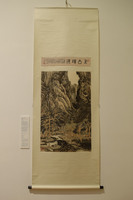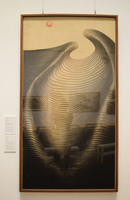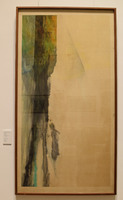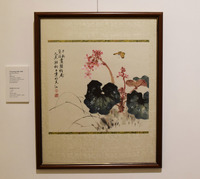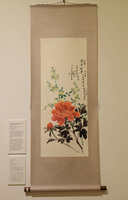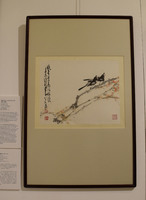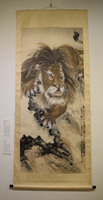| P011 | Ancient People 上古遺民 | Physical Object
Colour | Ink painting, Chinese
Life |
|
|
Type:Physical Object
Colour Subject:Ink painting, Chinese
Life |
Description:This is an ink painting by Wan Qingli (1945-2017). Tiny figures of men and women, including a breast-feeding mother and baby, form the centrepiece of this painting. All naked, they represent the inhabitants of a primitive village, living simple, self-sufficient lives. The controlled and dense brushwork is typical of paintings by Wang Meng(about 1308-1385), a celebrated painter from the late Yuan dynasty(1271-1368) who Wan Qingli greatly admired. [show more]
|
|
| P012 | Concentration 聚 | Physical Object
Colour | Ink painting, Chinese
Art, Abstract |
|
|
Type:Physical Object
Colour Subject:Ink painting, Chinese
Art, Abstract |
Description:This is an ink painting by Irene Chou (1924-2011). Swirling calligraphic lines form a mysterious, undulating mass at the centre of this work. While the composition evokes the sun above an undulating sea, it also creates the image of an inner universe, reflecting the artist's thoughts and emotions. [show more]
|
|
| P013 | Hope I 希之一 | Physical Object
Colour | Ink painting, Chinese
Art, Abstract |
|
|
Type:Physical Object
Colour Subject:Ink painting, Chinese
Art, Abstract |
Description:This is an ink painting by Chui Tze-hung (1936-Present)
|
|
| P014 | Hope II 希之二 | Physical Object
Colour | Ink painting, Chinese
Art, Abstract |
|
|
Type:Physical Object
Colour Subject:Ink painting, Chinese
Art, Abstract |
Description:This is an ink painting by Chui Tze-hung (1936-Present)
|
|
| P015 | Butterfly and Flowers 花蝶 | Physical Object
Colour | Ink painting, Chinese
Plants
Flowers
Lotus
Animals
Butterflies |
|
|
Type:Physical Object
Colour Subject:Ink painting, Chinese
Plants
Flowers
Lotus
Animals
Butterflies |
Description:This is an ink painting by Ye Shaobing (1896-1968)
|
|
| P016 | Birds and Flowers 花鳥 | Physical Object
Colour | Ink painting, Chinese
Animals
Birds
Plants
Flowers |
|
|
Type:Physical Object
Colour Subject:Ink painting, Chinese
Animals
Birds
Plants
Flowers |
Description:This is an ink painting by Yung Shau-shek (1907-1996)
|
|
| P017 | Sketch Demonstration of Peonies 牡丹課稿 | Physical Object
Colour | Ink painting, Chinese
Plants
Flowers
Peonies |
|
|
Type:Physical Object
Colour Subject:Ink painting, Chinese
Plants
Flowers
Peonies |
Description:This is an ink painting by Pau Siu-yau (1892-1985). The sketch was made using the 'boneless' method, in which washes of colour are applied to the paper without a guiding outline.
|
|
| P018 | Birds and Flowers 花鳥 | Physical Object
Colour | Ink painting, Chinese
Animals
Birds
Plants
Flowers |
|
|
Type:Physical Object
Colour Subject:Ink painting, Chinese
Animals
Birds
Plants
Flowers |
Description:This is an ink painting by Chao Shao-an (1905-1998). He created these album leaves after settling in Hong Kong. He is a second-generation painter of the Lingnan School and the School pioneered the reform of the Chinese painting tradition in the early 20th century by 'synthesising Chinese and Western art and harmonising ancient and modern art'. [show more]
|
|
| P019 | Gibbon, Maple Tree and Full Moon 月明猿啼詩意圖 | Physical Object
Colour | Ink painting, Chinese
Animals
Gibbons
Plants
Maple |
|
|
Type:Physical Object
Colour Subject:Ink painting, Chinese
Animals
Gibbons
Plants
Maple |
Description:This is an ink painting by Tseng Woon-wan (1915-1996)
|
|
| P020 | Enraged Lion 獅吼 | Physical Object
Colour | Ink painting, Chinese
Animals
Lion |
|
|
Type:Physical Object
Colour Subject:Ink painting, Chinese
Animals
Lion |
Description:This is an ink painting by Chiu Sai-kwong (1916-2007) and inscribed by Chao Shao-an (1905-1998). The inscription states that this work is a copy of a painting by Gao Qifeng (1889-1933), one of the founders of the Lingnan School. Gao's original was made for the Sun Yat-sen Memorial Hall in Guangzhou around 1926. It centred on the theme of the revolution. The ferocious-looking lion represents the reformist spirit of the era. The painting shows elements from new Japanese Nihonga (Japanese-style paintings), which combine Western realism and approaches to colour and light with traditional Japanese brushwork, materials and subject matter. [show more]
|
|

